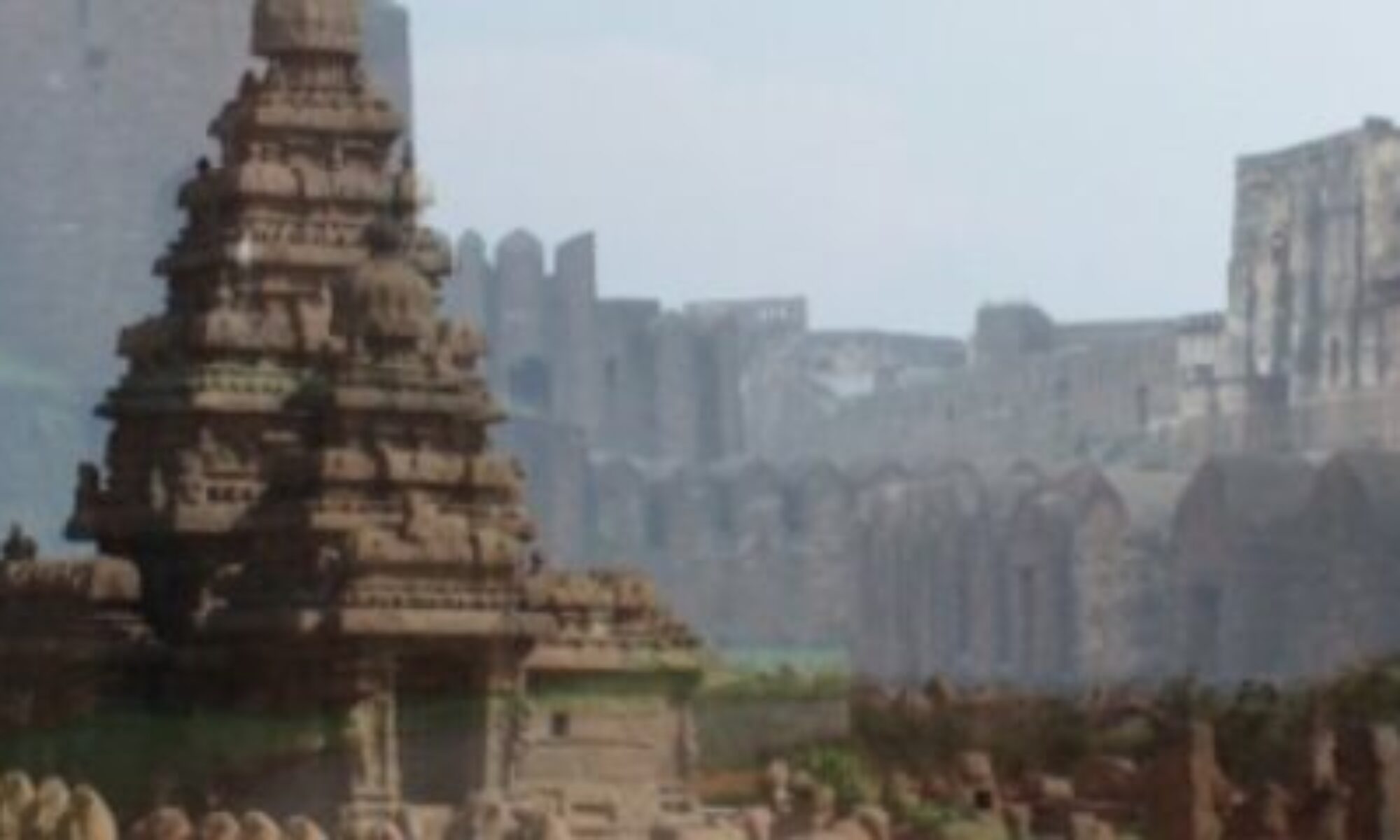Continued from the previous post…
Th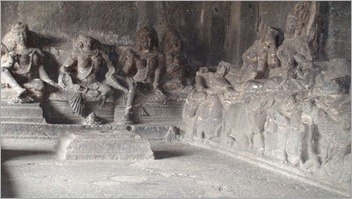 ere are long corridors on all three sides of the main temple and various sculptures are carved in long panels. First part of the corridor has been made as a separate cave where beautiful sculptures of the Saptamatrikas are placed on elevated basements. We had discussed about the Saptamatrikas in an earlier post about the Iconography in Hinduism. Most of the sculptures are disfigured with their heads broken and arms cut off. However, the designs on each sculpture are intact with their head-dresses and the jewelry.
ere are long corridors on all three sides of the main temple and various sculptures are carved in long panels. First part of the corridor has been made as a separate cave where beautiful sculptures of the Saptamatrikas are placed on elevated basements. We had discussed about the Saptamatrikas in an earlier post about the Iconography in Hinduism. Most of the sculptures are disfigured with their heads broken and arms cut off. However, the designs on each sculpture are intact with their head-dresses and the jewelry.
Under the fallen bridge, there is a huge sculpture of Ravana lifting the Kailas Mountain. This sculpture appears in multiple caves in Ellora and we had already seen in Cave 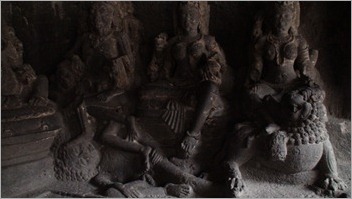 14. However, this specif
14. However, this specif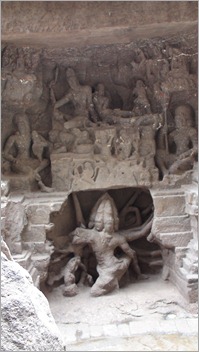 ic one shows the artist’s imagination and detail. Ravana, an ardent worshipper of Lord Siva thinks one day to shift the Kailas mountain to Lanka so that it will be easier to visit Siva and worship. The whole scene depicts the various actions around it. He, with his ten heads and twenty arms tries to lift the mountain. The attendants of Siva are confidently sitting beside as they know t
ic one shows the artist’s imagination and detail. Ravana, an ardent worshipper of Lord Siva thinks one day to shift the Kailas mountain to Lanka so that it will be easier to visit Siva and worship. The whole scene depicts the various actions around it. He, with his ten heads and twenty arms tries to lift the mountain. The attendants of Siva are confidently sitting beside as they know t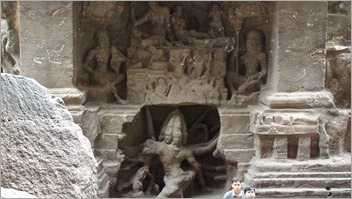 hat the Lord will take care of the situation. However, there are some dwarfs who are in doubt and are throwing stones below on Ravana to distract him. Parvati is afraid and clings to her husband. Parvati’s hands on Siva’s are also depicted clearly. Her maid, in fright at the shaking of the ground under her feet, is represented in the background fleeing for safety. Siva is pressing his toe down by force (the leg here is broken) which puts additional load on Ravana. Unable to bear the weight, he holds one leg down and tries to lift the mountain with all his strength. His face is also wretched with pain with wide eyes and the expression is also shown very
hat the Lord will take care of the situation. However, there are some dwarfs who are in doubt and are throwing stones below on Ravana to distract him. Parvati is afraid and clings to her husband. Parvati’s hands on Siva’s are also depicted clearly. Her maid, in fright at the shaking of the ground under her feet, is represented in the background fleeing for safety. Siva is pressing his toe down by force (the leg here is broken) which puts additional load on Ravana. Unable to bear the weight, he holds one leg down and tries to lift the mountain with all his strength. His face is also wretched with pain with wide eyes and the expression is also shown very 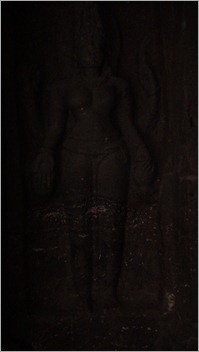 well.
well.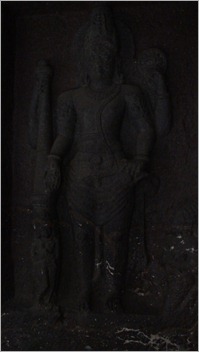
To see the above sculpture properly, we ascend into an unfinished cave in the right end of the court. A door in the front of it leads into the corridor which surrounds the whole back half of the court. On the right side, it measures 120 feet in length. The back is divided by pilasters into twelve compartments, each containing a large sculpture. Though this temple complex is dedicated to Siva, we find Vaishnava sculptures at some locations.
1) The First sculpture is of Annapurneshwari, the goddess of food. She is four armed and carries a kamandal (water-pot), a rosary and corn. Her fourth arm is in the granting attitude. 2) Second is of Vishnu with his club, conch and discuss, and a small female figure in front of his club. Some interpretations mention this sculpture as Balaji as well. 3) Third is an interesting piece. It is of Kris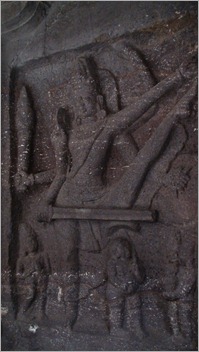 hna suppressing the great serpent, Kaliya. In our epics, it is mentioned that Krishna stood on top of its hood and performed a dance. However, this sculpture shows that Krishna holding the serpent’s tail and with one foot over its breast. This is pure artist imagination trying to carve with the limited space and resources.
hna suppressing the great serpent, Kaliya. In our epics, it is mentioned that Krishna stood on top of its hood and performed a dance. However, this sculpture shows that Krishna holding the serpent’s tail and with one foot over its breast. This is pure artist imagination trying to carve with the limited space and resources.
4) Next is Varaha with the goddess earth on his elbow. 5) The next statue is Vishnu sitting over his vehicle, Garuda, however, Garuda is represented in the human form, again an artist imagination. 6) Next is the familiar 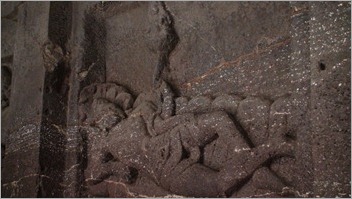 Trivikrama, the monstrous form of Vamana, who covers the earth and the sky in tri strides and places his third step upon the King Bali. He has six arms, with a long sword, a club, shield, the Sankha and the Chakra. 7) Krishna lifting the Govardhana hill and
Trivikrama, the monstrous form of Vamana, who covers the earth and the sky in tri strides and places his third step upon the King Bali. He has six arms, with a long sword, a club, shield, the Sankha and the Chakra. 7) Krishna lifting the Govardhana hill and 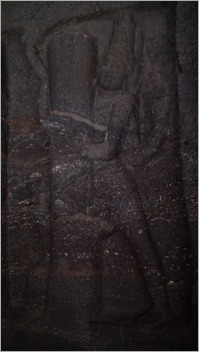 his flock taking shelter under it. 8) Vishnu resting on a giant snake, and Brahma sitting on the lotus that sprang out of Vishnu’s navel. 9) Nara
his flock taking shelter under it. 8) Vishnu resting on a giant snake, and Brahma sitting on the lotus that sprang out of Vishnu’s navel. 9) Nara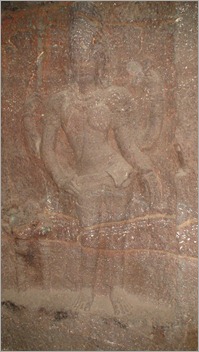 simha, the man lion killing the demon Hiranyakasipu. This is the last sculpture of Vaishnava sect in this cave. All further ones are purely Saiva 10) This is a very interesting sculpture where you see a man holding a Siva Linga with both the hands. Ravana, being a great devotee of Siva performed a penance and acquired the Atma Linga (Linga’s soul). However, there was a condition. He was not supposed to place the Linga down till he reaches Lanka. It is said, that at a place called Gokarna in Karnataka, due to a trick played by the other gods the linga starts becoming heavier. He places the Linga down for a while and it does not come up again. So here in this sculpture, Ravana is show
simha, the man lion killing the demon Hiranyakasipu. This is the last sculpture of Vaishnava sect in this cave. All further ones are purely Saiva 10) This is a very interesting sculpture where you see a man holding a Siva Linga with both the hands. Ravana, being a great devotee of Siva performed a penance and acquired the Atma Linga (Linga’s soul). However, there was a condition. He was not supposed to place the Linga down till he reaches Lanka. It is said, that at a place called Gokarna in Karnataka, due to a trick played by the other gods the linga starts becoming heavier. He places the Linga down for a while and it does not come up again. So here in this sculpture, Ravana is show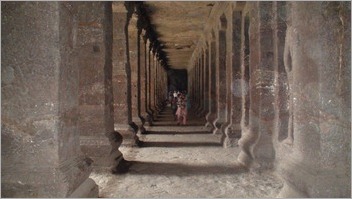 n trying to lift the linga with both his hands. 11) Next is Siva, four armed with his vehicle, the Nandi. 12) The final one
n trying to lift the linga with both his hands. 11) Next is Siva, four armed with his vehicle, the Nandi. 12) The final one 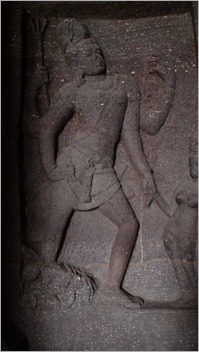 in this row is a sculpture of Artha Narishwar, Siva represented has Parvati in half of his body. Even the body, attire and standing posture depict this form.
in this row is a sculpture of Artha Narishwar, Siva represented has Parvati in half of his body. Even the body, attire and standing posture depict this form.
We e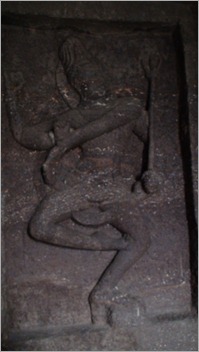 nter the back corridor which is 190 feet in length with 18 compartments.
nter the back corridor which is 190 feet in length with 18 compartments.
1) Siva, depicted as Kala Bhairava, four armed, with the trisula, and a small figure of Parvati, her hair done up in a peculiar style.
2) Siva stepping out from lotuses, with a small figure of Parvati holding him by the finger.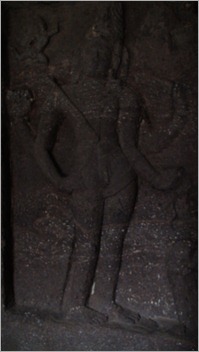
3) Siva, four-armed, with trisula, one right hand on Parvati’s head and other other on her breast.
4) Siva, four-armed, with trisula in his left hand, gandharvas above, and attendant below.
5) Siva, in the posture of Ananda Tandav dance with a long shafted trisula in one of his hands.
6) This represents Siva and Parvati as prakriti and purush. Siva and Parvati are depicted naked. This is also called as the Bhikshatana Murthi owing the bowl in his hand.
7) Siva, four-armed with Nandi on his right and Parvati in front of him.
8) Brahma, with four heads (the fourth hidden behind) with his vehicle, the swan, four armed with a kamandala in his hand. It is an important trivia to note that there is only one temple in India dedicated to Brahma, in Pushkar Rajasthan.
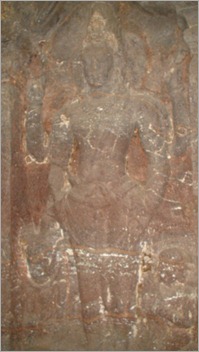 9) Even though Vishnu comes second after Brahma, here Siva stands second. The main reason for this is that this sculpture is exactly in line with the idol in the sanctum of the temple in front.
9) Even though Vishnu comes second after Brahma, here Siva stands second. The main reason for this is that this sculpture is exactly in line with the idol in the sanctum of the temple in front.
10) Vishnu, with his conch and wheel
11) This sculpture is quite unique in nature and depicts a new thought process. A figure with trisula and Nandi and also sankha, chakra along with Garuda. As an amalgamation of two gods, this is named Harihara. This thought was expressed and followed by Sri Adi Sankaracharya, who started the Advait movement in India.
12) This is named Gangadhar, as the Siva directs the 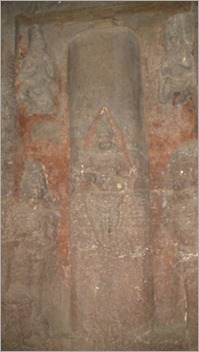 river Ganges to flow towards his jata (matted hair) and fall down below to the earth.
river Ganges to flow towards his jata (matted hair) and fall down below to the earth.
13) This image is called the lingodbhavamurthi where Siva emerges out of the Linga. There is a puranic story attributed to it which I will not go in to detail. This story gives the analogy why Brahma is worshipped less. Brahma, Vishnu and the Varaha form of Vishnu are depicted praying to Siva. Some trivia again on this. Brahma was initially said to have five faces as I had mentioned during the discussion on Ic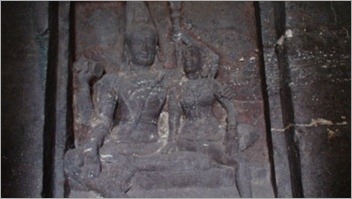 onography in Hinduism. Siva, due to some situations had cut off the fifth face. In order to wash away the sin committed by Siva, Nandi advises him to go to Nasik and take a holy dip one of the rivers. Siva is in the form of Kapaleshwar in a temple dedicated to
onography in Hinduism. Siva, due to some situations had cut off the fifth face. In order to wash away the sin committed by Siva, Nandi advises him to go to Nasik and take a holy dip one of the rivers. Siva is in the form of Kapaleshwar in a temple dedicated to 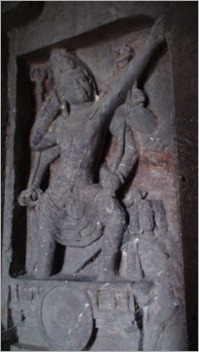 him in Nasik. You will not find the commonly found Nandi over there, as Siva at that time considered Nandi as his teacher.
him in Nasik. You will not find the commonly found Nandi over there, as Siva at that time considered Nandi as his teacher.
14) Siva, four-armed with Nandi and his dumru.
15) Siva and Parvati sitting together, with Nandi below.
16) Siva, holding his bow named Pinak going to war against Tripurasura. Brah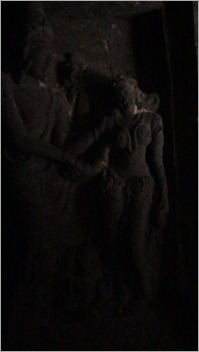 ma is shown as the charioteer and Nandi as an ensign.
ma is shown as the charioteer and Nandi as an ensign.
17) A continuation to the previous sculpture, Virabhadra, six armed with damru, trisula and bowl to catch the blood of Ratnasura – for every drop of it that fell to the ground produced another demon like himself.
18) The marriage of Siva and Parvati. Parvati is richly decorated with fine jewelry and the specimens of them are still worn today in Hindu marriages. There is a very interesting analogy to this sculpture due to which it is one of the most famous icons in the Kailas Temple. Generally, during marriage, the hand of the lady is placed upon the male’s. However, here we see the opposite. The analogy here is that as Pavati performed penance for being the wife of Siva, and not vice versa, she has the upper hand and with that authority, she had taken Siva’s hand on hers. Siva places his hand over Parvati’s shoulder and Parvati feels shy. This is beautifully depicted in her standing posture where she presses the tip of the toe of one feet over the other. Brahma is shown performing the wedding.
We now come to the end of the back corridor. We shall continue with the rest of the temple in the further posts.
